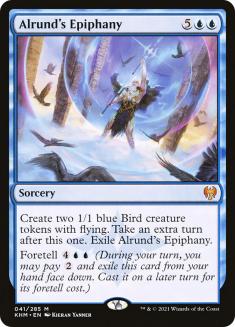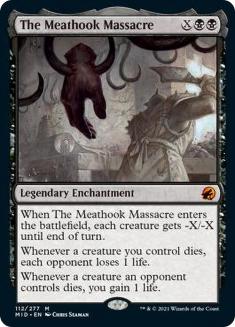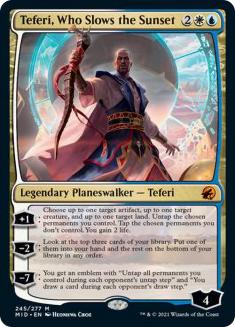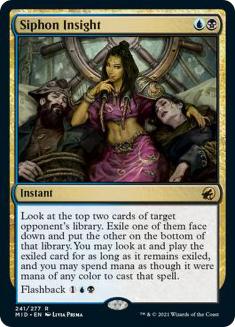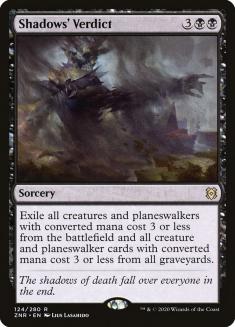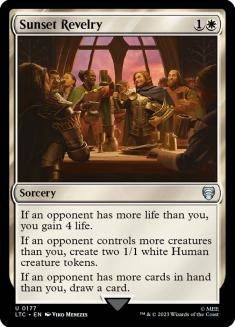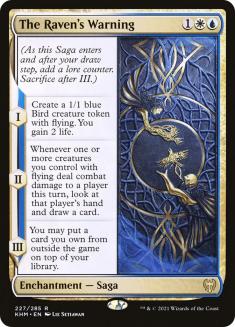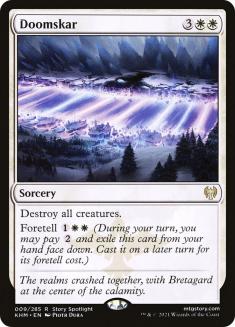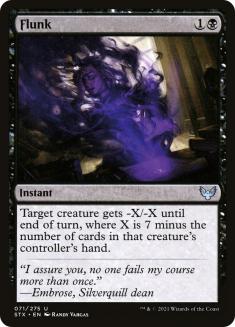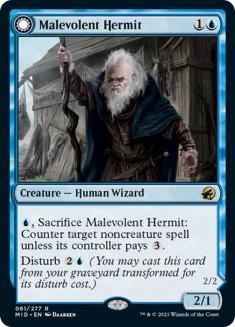Magic Twitter has been stirred up this past week, with outrage aimed at every aspect of the game we love. Some of this anger was well-deserved, as the deck lists for Worlds’ competitors inadvertently poured into the public, but other cases were not that cut and dry. I have been playing competitively for a very long time, and in all my experiences, I have never seen a format get declared dead on arrival this soon after a rotation. There will always be complainers in every genre of hobby; however, some of the players calling Standard awful from the start are folks I hold in high regard. Their opinions were historically well thought out, with that streak coming to an abrupt ending.
The “Standard sucks” crew is easy to disregard, with my attention focusing on players that have specific ban requests to, in their mind, improve the format. The first card that received the mob’s ire was Esika’s Chariot. Just your typical snowball-effect, midrange green card, which is something we should all be used to. The rotation, and bannings before that, did a good job of eliminating most issues that fell under this umbrella, but missed this one. As good as Esika’s Chariot is, I disagreed with the pitchfork-wielding folks right off the bat and still hold the same opinion. Chariot is beatable, although I feel the same frustration that got these critics hot in the first place.
The days of dealing with a permanent and leaving no residual effect behind are over. I had to accept that many years ago and it is now time the rest of my players follow suite. I yearn for the play series of hitting a big old threat with Cancel, letting another slip through the blue defenses, and then spin around with a Doom Blade to clear the battlefield. This was my favorite era, as it was for many of you, but it’s dead and aint coming back. I would be floored if they ban Esika’s Chariot now, or at any point in its time in Standard.
Esika’s Chariot was quickly tossed aside in the ban conversation for Alrund’s Epiphany. This one I saw coming, as it was very annoying to play against in the previous Standard. Opponents taking extra turns is up there as one of the least fun interactions, this coming from a guy whose top Commander is Urza, Lord Artificer, with thirteen unique Time Walk effects that are fueled by artifacts. I know it’s not fun, we all know it’s not fun, but entertainment does not always equate to balance. It took me a while to figure out that people love Modern, regardless of how ridiculous the gameplay is, due to the cranked-up power level. Standard is a different ballgame though and every time there’s a strong spell that gets you an extra turn, it’s problematic.
My stance on Alrund’s Epiphany is like Esika’s Chariot. I do not think they should ban either, but there’s a chance that the Time Warp gets the hammer. Hatred of an effect that’s loud enough can move the decision makers to get rid of it, as they are driven partially by the bottom line. If the popularity is affected, causing less cash to flow through their coffers, action will be taken. Nexus of Fate was cast at instant-speed and used Wilderness Reclamation to go wild, which is why it should have been banned. Even without those other elements, it was still not fun to play against and caused people to call for its head. I would not get too used to Alrund’s Epiphany sticking around, but I think it’s a mistake to ban it at this point.
I wrote about Dimir Control against the field last week and now it’s time to rock a three-color control strategy. Esper Control is my bread and butter, the yin to my yang, and every other strong pair out there. Outside of it being my personal license plate and pseudo-identity, it historically houses the strongest elements of control within the shard. The sweepers and removal from Orzhov, combined with the card draw and disruption from blue, makes Esper Control my go-to whenever applicable. The mana is what has held me back from it at the start of this new Standard; however, the tradeoff of Doomskar, Vanishing Verse, and some spicy planeswalkers may be worth the risk. Let us look at the list, then see how to attack the top Magic World Championship XXVII decks with it.
Creatures (2)
Planeswalkers (3)
Lands (26)
Spells (29)
- 2 Negate
- 2 Jwari Disruption
- 4 Saw It Coming
- 4 Doomskar
- 4 Vanishing Verse
- 3 Flunk
- 1 Infernal Grasp
- 3 Siphon Insight
- 2 The Meathook Massacre
- 4 Memory Deluge
Sideboard

Matchup Analysis
VS Mono-Green Aggro❄
Creatures (19)
- 2 Tangled Florahedron
- 4 Kazandu Mammoth
- 4 Old-Growth Troll
- 4 Sculptor of Winter
- 4 Werewolf Pack Leader
- 1 Primal Adversary
Planeswalkers (2)
Lands (23)
Spells (16)

The reason to switch from Dimir to Esper Control is the matchup against Mono-Green Aggro❄. The Dimir Control win percentage against it isn’t terrible; however, Esper Control has the tools to make the matchup difficult for any deck weak to Doomskar. Outside of Old-Growth Troll, every creature in the deck falls to the white sweeper of the format, making the matchup shift in favor of the control team. Not only does white bring us Doomskar for this matchup, but it also provides Vanishing Verse, a card that annihilates any permanent that Mono-Green Aggro❄ can produce. The only threat that’s resilient to this removal package, and not Dimir Control’s, is Faceless Haven. There are three copies of Flunk and one Infernal Grasp, which need to be used strategically, to avoid struggling against one creature-land when everything else has been easily dealt with.
Out:
In:
Mono-Green Aggro❄ likely falls Game 1 to Esper Control but fights back with Snakeskin Veil after sideboard. This is not Veil of Summer and can line up poorly if caught by a sweeper at the right time. Esper Control cranks up its sweeper count after sideboard, punishing the aggro opponent for over-extending most of the time. Outside of a few tricks and bigger threats, Mono-Green Aggro❄ doesn’t gain much traction in the sideboarded games, making this a good matchup for Esper Control. The biggest enemy Esper Control has in the aggro matchup is its manabase, but luckily Mono-Green Aggro❄ doesn’t toss out a bunch of one-drops to penalize a slow mana draw.
VS Mono-White Aggro❄
Creatures (29)
- 4 Luminarch Aspirant
- 4 Usher of the Fallen
- 3 Reidane, God of the Worthy
- 4 Elite Spellbinder
- 3 Stonebinder's Familiar
- 4 Intrepid Adversary
- 4 Sungold Sentinel
- 3 Adeline, Resplendent Cathar
Lands (24)
Spells (7)

As with Dimir Control, this is my favorite matchup to beat up on in the format. Linear is a term that has been perceived as derogatory, but that’s not at all the intent. This is a prime example of a linear aggro deck, one that produces as many early threats as possible, with equipment and removal to push back opposing blockers. That’s the deck in its entirety, but that does not mean it’s easier to play than others. In Magic terms, linear is a descriptor to identify the main path to victory, usually a strong path, where outside of that defined gameplan, it’s very difficult to win. Esper Control does a great job of gumming that path up with the best removal and sweepers, making it very difficult to make a late-game stand.
The creatures in this deck have notoriously low toughness, making The Meathook Massacre another devastating sweeper to add to Doomskar. This makes six sweepers in the maindeck, with eight targeted removal spells on Turn 2. Unlike aggro decks of the past, these creatures do not produce the advantage while on the battlefield, nor do they have resilience to destroy effects, making this matchup the best possible for my Esper Control fans. It also summons the power of Faceless Haven, a point to keep aware of when dispatching removal against pitiful threats that can barely cause harm in the mid to late-game.
Out:
In:
In the sideboard games, Mono-White Aggro❄ has enlisted the help from Guardian of Faith. This card is a game changer and must be respected, as it can destroy anyone caught off guard. Sweepers are the backbone of Esper Control, which may lead to see the amount we’re working with in the sideboarded games. With an additional two, that makes eight total copies to wreak havoc with Game 2 and Game 3. The ninth potential sweeper I leave in the sideboard, to fetch up with The Raven’s Warning, another sweet card I have waited a while to get into the lineup. The creature it makes can trade with theirs, or do its main job of drawing a card, seeing their hand, and gaining two life. After that is all said and done, it tutors anything to the top of the library from the sideboard, likely a sweeper to take out the aggressive wave with ease.
VS Grixis Epiphany/Izzet Epiphany
Creatures (4)
Lands (23)
Spells (33)
- 2 Duress
- 1 Bloodchief's Thirst
- 2 Spikefield Hazard
- 1 Cinderclasm
- 2 Jwari Disruption
- 4 Alrund's Epiphany
- 1 Demon Bolt
- 1 Prismari Command
- 4 Expressive Iteration
- 1 Power Word Kill
- 2 Galvanic Iteration
- 3 The Celestus
- 1 Burn Down the House
- 3 Memory Deluge
- 1 Cathartic Pyre
- 4 Fading Hope
Sideboard

Lands (23)
Spells (37)

The strategy to defeat Alrund’s Epiphany does not vary between Grixis and Izzet for Esper Control. The black added, as you can see with Eli’s decklist here, was to bring in additional removal support against the aggro decks, while having access to Duress for the mirror. This is a smart move by the Grixis Epiphany team, as the additional third color here does not affect the mana much. As with Esper Control, the Turn 1 tapped land does not derail the deck much in this metagame, so the reward often outweighs the risk.
Esper Control is a slight underdog Game 1 against these decks, due to the amount of removal that will go unused. Grixis and Izzet Epiphany also have a sizable number of dead cards; however, their late-game is very impressive. Izzet Epiphany has more card advantage production, making it difficult to keep up without sideboard assistance, while Grixis Epiphany can hit you with a timely Duress Game 1. Esper Control has its fair share of strong blue cards to combat these villains in the first game; however, it ‘s not the best positioned until Game 2 and Game 3. This is a strategic choice, to keep Esper Control strong against creatures Game 1, then transitioning to a late-game killer in the sideboarded games.
Out:
In:
I’m not impressed by the Izzet Epiphany sideboard, mainly due to its lost slots from the Learn mechanic. It has some creatures that come in, all of which are eviscerated by Vanishing Verse with ease. This is where Esper Control shines and Dimir Control struggles, exiling resilient threats out of the blue sideboards. The Grixis Epiphany deck has a few more tricks up its sleeve, with an additional Duress and a couple copies of Go Blank. Hand disruption is a way to rattle Esper Control in the sideboard games, but not enough to gain advantage. With the additional Duress, two copies of Negate, and four copies of Malevolent Hermit, the control player can fend off the very strong late-game of both Alrund’s Epiphany decks.
Moving Forward
This matchup analysis covers the major archetypes that we see represented at Magic World Championship XXVII this year. The outlier decks, Azorius Aggro, Izzet Dragons, and Temur Midrange, all fall under one of the discussed breakdowns. Azorius Aggro is nearly identical to Mono-White Aggro❄, the same being true for Izzet Dragons joining the Izzet Epiphany gang. The Temur Midrange deck is something I run into online, during testing occasionally, and is defeated along the same lines as Mono-Green Aggro❄. There are notably large creatures in this deck that are unique, a nice group of Dragons, but the removal in Esper Control targets them just as effectively. Since Doomskar is the sweeper of choice and not one of the stipulation-attached black versions, all creatures are easily slain. The only area to be cautious is the blue splash, which opens the spell book for Negate and Disdainful Strike to ruin your day.
Otherwise, these decks are very similar to the Tier 1 decks discussed above, all of which are decent matchups for this version of Esper Control.


